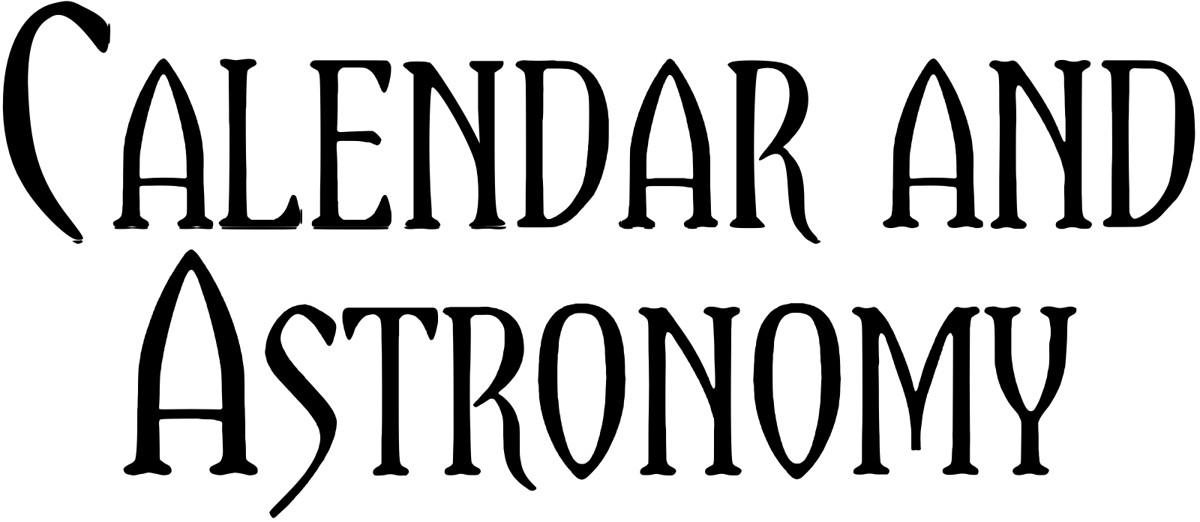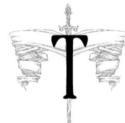The Wolf Age (73 page)
Authors: James Enge
Tags: #Werewolves, #General, #Ambrosius, #Fantasy, #Morlock (Fictitious character), #Fiction

Sheltering the three flames under his wings from the midsummer blizzard, the crooked man took the long road south.
This, lacomes, is the extent of my visualization. May I return now, to rest among my stones?




1. ASTRONOMICAL REMARKS
 he sky of Laent has three moons: Chariot, Horseman, and Trumpeter (in descending order of size).
he sky of Laent has three moons: Chariot, Horseman, and Trumpeter (in descending order of size).
The year has 375 days. The months are marked by the rising or setting of the second moon, Horseman. So that (in the year before The Wolf Age begins) Horseman sets on the first day of Bayring, the penultimate month. It rises again on the first of Borderer, the last month. It sets very early in the morning on the first day of Cymbals, the first month of the new year. All three moons set simultaneously on this occasion. (The number of months are uneven-fifteen-so that Horseman rises or sets on the first morning of the year in alternating years.)
The period of Chariot (the largest moon, whose rising and setting marks the seasons) is 187.5 days. (So a season is 93.75 days.)
The period of Horseman is 50 days.
The period of Trumpeter is 15 days. A half cycle of Trumpeter is a "call." Calls are either "bright" or "dark" depending on whether Trumpeter is aloft or not. (Usage: "He doesn't expect to be back until next bright call.")
The seasons are not irregular, as on Earth. But the moons' motion is not uniform through the sky: motion is faster near the horizons, slowest at zenith. Astronomical objects are brighter in the west, dimmer in the east.
The three moons and the sun rise in the west and set in the east. The stars have a different motion entirely, rotating NWSE around a celestial pole. The pole points at a different constellation among a group of seven (the polar constellations) each year. (Hence, a different group of nonpolar constellations is visible near the horizons each year.) This seven-year cycle (the Ring) is the basis for dating, with individual years within it named for their particular polar constellations.
The polar constellations are the Reaper, the Ship, the Hunter, the Door, the Kneeling Man, the River, and the Wolf.
There is an intrapolar constellation, the Hands, within the space inscribed by the motion of the pole.
Solar eclipses are rare but not unheard-of. They do not involve the three known moons. Some speculate that there is a fourth nonluminous moon whose course runs north-south through the sky. Others insist that the sun has a nonluminous hemisphere that appears as the sun rotates at irregular intervals.
2. THE YEAR$ OF THE WOLF AGE
The calendar below was first developed in the Wardlands, and then spread to the unguarded lands by exiles. In the Wardlands, years are dated from the founding of New Moorhope, the center of learning. The action of The Wolf Age begins in the 465th Ring, Moorhope year 3247, the Year of the Reaper. But in the Ontilian Empire, the years are dated from the death of Uthar the Great, a system that came into widespread use north and south of the Kirach Kund. According to that scheme, the action begins in 335 A.U.

335 A.U.
3247 M.Y., Year of the Reaper in the 465th Ring
1. Cymbals.
New Year. Winter begins.
1st: Chariot, Horseman, and Trumpeter all set.
8th and 23rd: Trumpeter rises.
2. )aric.
1st: Horseman rises. 13th: Trumpeter rises.
3. Brenjing.
1st: Horseman sets. 3rd and 18th: Trumpeter rises.
4. Drums.
1st: Horseman rises. 8th and 23rd: Trumpeter rises.
Midnight of 94th day of the year (19 Drums): Chariot rises. Spring begins.
5. Rain.
1st: Horseman sets. 13th: Trumpeter rises.
6. Marrying.
1st: Horseman rises. 3rd and 18th: Trumpeter rises.
7. Ambrose.
1st: Horseman sets. 8th and 23rd: Trumpeter rises.
8. Harps.
1st: Horseman rises. 13th: Trumpeter rises.
Evening of the 188th day of year (19 Harps): Chariot sets.
Midyear-summer begins.
9. Tort
1st: Horseman sets. 3rd and 18th: Trumpeter rises.
10. Remembering.
1st: Horseman rises. 8th and 23rd: Trumpeter rises.
11. Victory.
1st: Horseman sets. 13th: Trumpeter rises.
12. Harvesting.
1st: Horseman rises. 3rd and 18th: Trumpeter rises.
6th: Chariot rises, noon of 281st day of year. Fall begins.
13. Mother and Maiden.
1st: Horseman sets. 8th and 23rd: Trumpeter rises.
14. Bayrin~.
1st: Horseman rises. 13th: Trumpeter rises.
15. Borderer.
1st: Horseman sets. 3rd and 18th: Trumpeter rises.

336 A.U.
3248 M.Y., Year of the Ship in the 465th Ring
i. Cynjbal5.
New Year. Winter begins.
1st: Chariot and Trumpeter set. Horseman rises.
8th and 23rd: Trumpeter rises.
2. Jari(.
1st: Horseman sets. 13th: Trumpeter rises.
3. Brenling.
1st: Horseman rises. 3rd and 18th: Trumpeter rises.
4. Drun)5.
1st: Horseman sets. 8th and 23rd: Trumpeter rises.
Midnight of 94th day of the year (19 Drums): Chariot rises. Spring begins.
5. Rain.
1st: Horseman rises. 13th: Trumpeter rises.
6. Marrying.
1st: Horseman sets. 3rd and 18th: Trumpeter rises.
7. Ambrose.
1st: Horseman rises. 8th and 23rd: Trumpeter rises.
8. Harps.
1st: Horseman sets. 13th: Trumpeter rises.
Evening of the 188th day of year (19 Harps): Chariot sets.
Midyear-summer begins.
9. Tort
1st: Horseman rises. 3rd and 18th: Trumpeter rises.
10. Rememberip~.
1st: Horseman sets. 8th and 23rd: Trumpeter rises.
11. Victory.
1st: Horseman rises. 13th: Trumpeter rises.
12. Haru iog.
1st: Horseman sets. 3rd and 18th: Trumpeter rises.
6th: Chariot rises, noon of 281st day of year. Fall begins.
13. MoJOer and Maideq.
1st: Horseman rises. 8th and 23rd: Trumpeter rises.
14. Bayrigg.
1st: Horseman sets. 13th: Trumpeter rises.
15. Borderer.
1st: Horseman rises. 3rd and 18th: Trumpeter rises.


